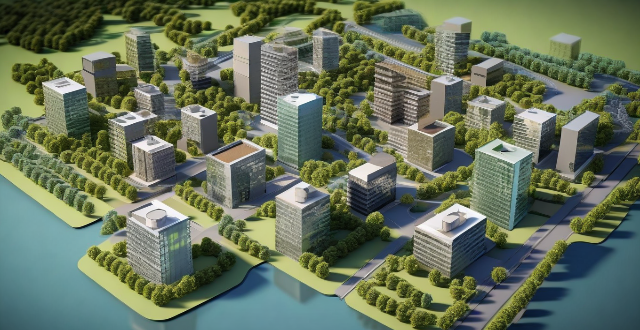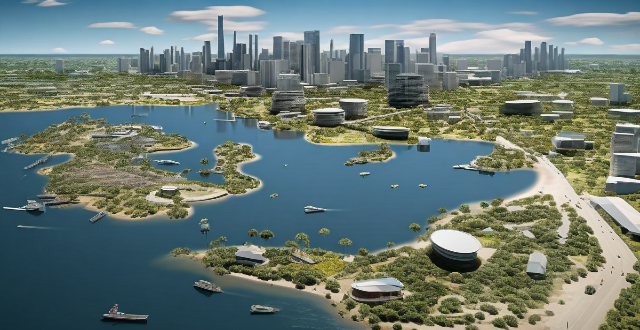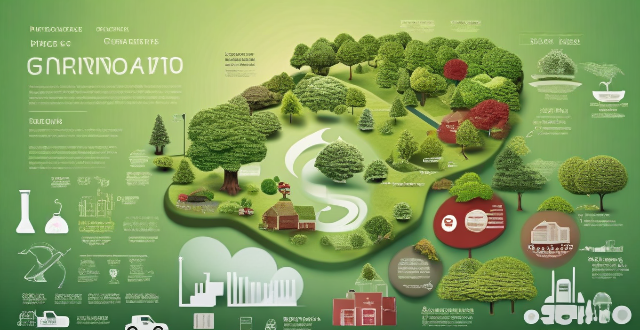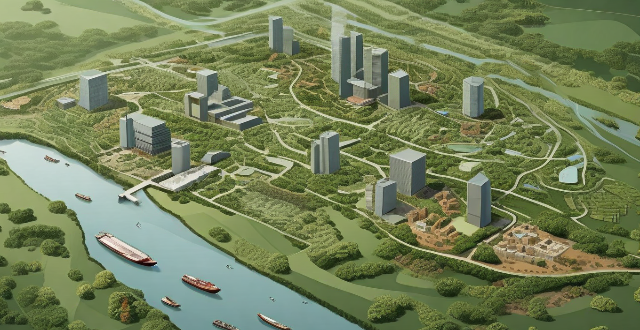Reduce Greening

How do urban greening projects influence city temperatures and heat islands ?
Urban greening projects, such as planting trees and creating parks, can help reduce city temperatures and mitigate the effects of urban heat islands. These projects provide shade, reduce heat absorption by buildings and roads, and promote evapotranspiration, all of which contribute to cooler city environments. By increasing vegetation in cities, urban greening initiatives can also help reduce the intensity of urban heat islands, making cities more comfortable for residents. As our world continues to urbanize, prioritizing urban greening initiatives is essential for creating healthier and more sustainable cities for future generations.

What are the benefits of urban greening projects ?
Urban greening projects offer a multitude of benefits including improved air quality, climate regulation, water management, enhanced aesthetics and livability, mental and physical health improvements, community building, habitat creation and preservation, food production, job creation, energy conservation, and tourism attraction. These initiatives aim to increase the amount of greenery in cities, such as parks, gardens, green roofs, walls, street trees, and other forms of urban forestry. The advantages of urban greening are multifaceted and contribute significantly to the improvement of urban environments for both residents and wildlife.

How do urban greening projects affect biodiversity in cities ?
Urban greening projects, which aim to increase the amount of vegetation within cities, can have significant effects on urban biodiversity. These projects typically involve planting trees, creating parks and green spaces, and restoring natural habitats. Here are some ways in which these initiatives can influence the variety of species living in urban areas: - Increased Habitat Availability: By adding more greenery, urban greening provides additional habitats for a wide range of organisms. This includes plants, insects, birds, and small mammals that can thrive in these newly created environments. - Mitigation of Urban Heat Islands: Vegetation helps reduce the urban heat island effect by providing shade and releasing water through transpiration, creating cooler microclimates that are more suitable for certain species. - Enhanced Food Sources: Flowering plants attract pollinators like bees and butterflies, supporting their populations and contributing to the health of the overall ecosystem. - Increased Water Quality and Availability: Green roofs and rain gardens help manage stormwater runoff, reducing pollution and providing water sources for urban wildlife. - Promotion of Biodiversity through Education and Awareness: Parks and green spaces serve as outdoor classrooms, offering opportunities for education about ecology and conservation. While urban greening projects offer numerous benefits for biodiversity, they also present challenges such as potential introduction of invasive species, maintenance requirements, and resource allocation trade-offs with other land uses.

How can cities encourage citizen participation in greening projects ?
This article discusses various strategies that cities can adopt to encourage citizen participation in greening projects, including education and awareness, volunteer opportunities, incentives and recognition, and collaboration with local organizations. By implementing these strategies, cities can create vibrant, sustainable environments that benefit both residents and the planet.

How do city greening projects contribute to environmental sustainability ?
City greening projects are vital for environmental sustainability, addressing issues like heat island effects, air quality, biodiversity, and more. They beautify urban landscapes, contribute to sustainable living, and offer economic benefits. Key considerations include diverse planting, maintenance, and community involvement.

What challenges do urban planners face when implementing greening projects ?
Urban planners face numerous challenges when implementing greening projects in cities, including a lack of available space, high costs, resistance from stakeholders, climate change impacts, and maintenance and management issues.

What role do community gardens play in city greening efforts ?
Community gardens play a significant role in city greening efforts by providing environmental, social, economic, and urban planning benefits. These gardens improve air quality, enhance biodiversity, and promote soil health. They also foster community building, offer educational opportunities, and contribute to health promotion. Economically, community gardens provide food security and create job opportunities. Integrated into urban planning, they beautify cities and promote sustainable development. Overall, community gardens are vital for ecological health and improving residents' quality of life.

How do green roofs and walls contribute to city greening ?
Green roofs and walls contribute to city greening by improving air quality, mitigating the urban heat island effect, enhancing biodiversity, managing stormwater, increasing energy efficiency, providing aesthetic value, and promoting community well-being.

Can using a carbon footprint calculator help reduce my environmental impact ?
Using a carbon footprint calculator can help individuals reduce their environmental impact by raising awareness, identifying areas for improvement, setting goals, tracking progress, and encouraging sustainable habits.

Can regular physical activity reduce anxiety levels ?
Regular physical activity can help reduce anxiety levels by improving mood, reducing stress hormones, promoting better sleep, increasing self-esteem and confidence, and providing social support. Engaging in at least 30 minutes of moderate-intensity exercise per day can significantly reduce anxiety symptoms.

Can certain foods help reduce inflammation in athletes
Certain foods can help reduce inflammation in athletes. These include anti-inflammatory spices, fruits and vegetables, whole grains, healthy fats, and protein. It's also important to avoid processed foods, sugary drinks, and red meat. By eating a balanced diet full of healthy foods, athletes can reduce inflammation and improve their performance.

Can upgrading my internet package reduce network latency ?
The text discusses the topic of network latency and whether upgrading an internet package can reduce it. It outlines various factors affecting network latency, including ISP infrastructure, type of connection, location, and network devices. The text then explores different upgrade scenarios, such as moving from DSL to fiber optic or increasing bandwidth, and their potential impact on reducing latency. It concludes that while upgrading can potentially reduce latency, the specifics of each situation should be considered before deciding to upgrade.

Can Climate-Smart Technologies help reduce global warming ?
Climate-smart technologies, designed to mitigate and adapt to climate change impacts, aim to reduce greenhouse gas emissions, enhance carbon sequestration, and improve resource efficiency. These technologies can help reduce global warming through energy efficiency, renewable energy, and carbon capture and storage. They also aid in adaptation through water management, agricultural innovation, and early warning systems. Co-benefits include resource conservation, economic growth, and health improvements. However, scaling up these technologies, policy support, and equity are challenges that need to be addressed for their successful implementation.

Can music help reduce perceived exertion during exercise ?
Music can help reduce perceived exertion during exercise by positively influencing mood and cognition, and acting as a distraction from bodily symptoms associated with fatigue. Numerous studies have shown the benefits of music on perceived effort levels during workouts, but individual preferences and contextual factors play significant roles. To potentially benefit from reduced perceived exertion, it's important to select music that resonates personally and matches the intensity of your workout.

Can exercise reduce the risk of developing cardiovascular diseases ?
Cardiovascular diseases (CVDs) are a leading cause of death worldwide, and regular physical activity or exercise is one of the most effective ways to reduce the risk of developing them. Exercise helps improve blood circulation, lower cholesterol levels, reduce inflammation, manage weight, and improve glucose control. The American Heart Association recommends at least 150 minutes per week of moderate-intensity aerobic activity or 75 minutes per week of vigorous-intensity aerobic activity, along with muscle-strengthening activities at least two days per week.

How can insurers help promote sustainability and reduce carbon emissions ?
Insurance companies can promote sustainability and reduce carbon emissions by offering sustainable insurance products, encouraging sustainable practices among clients, investing in sustainable projects, and reducing their own carbon footprint.

What are some easy ways to reduce sugar intake in my diet ?
Reducing sugar intake is crucial for a healthy lifestyle. Here are ways to reduce sugar in your diet: read food labels, avoid sugary drinks, choose whole foods, cook at home, swap sweet treats for healthier options, limit added sugars in beverages, and gradually reduce sugar intake. By following these steps, you can significantly lower your sugar consumption and improve your overall health.

How can I reduce the calorie count of my favorite pasta dishes ?
How to reduce the calorie count of your favorite pasta dishes? To reduce the calorie count of your favorite pasta dishes, you can use whole grain pasta, add more vegetables, use low-fat dairy products, reduce the portion size, and use herbs and spices instead of heavy sauces. Whole grain pasta has more fiber than regular pasta, which helps you feel fuller for longer and reduces the number of calories you consume. Adding more vegetables to your pasta dish will not only increase the nutritional value but also help you feel fuller with fewer calories. If your pasta dish includes dairy products like cheese or cream, consider using low-fat versions instead. Reducing the portion size is an obvious but effective way to reduce calorie intake. Using herbs and spices instead of heavy sauces can also reduce the calorie count of your pasta dish. By following these tips, you can enjoy your favorite pasta dishes while maintaining a healthy diet.

How can we reduce our exposure to harmful chemicals in everyday life ?
In today's world, it is nearly impossible to entirely avoid exposure to harmful chemicals. However, there are several steps we can take to significantly reduce this exposure and protect our health. Here are some practical tips: - Choose natural products for food, beverages, personal care, and cleaning agents. - Avoid plastic by using glass or stainless steel water bottles, storing food in glass containers, and opting for reusable alternatives for straws and cutlery. - Create a healthier home environment by choosing furniture made from natural materials, maintaining good air quality, and selecting natural fabrics for clothing and decor. - Wear clothing made from organic cotton or other sustainable materials, be mindful of dyes and finishes used in clothing, and use natural or eco-friendly detergents for washing clothes. - Choose non-toxic cookware and BPA-free plastic containers for food storage. - Limit the use of electronic devices that may emit EMFs, especially before bedtime, and consider wired headphones over wireless ones to reduce exposure to Bluetooth radiation.

How can multicultural education help reduce racial and ethnic discrimination ?
Multicultural education is crucial in combating racial and ethnic discrimination. It fosters cultural awareness, intercultural competence, challenges biases, promotes social justice, builds inclusive communities, and prepares global citizens. By doing so, it helps reduce discrimination and creates a more equitable and harmonious society.

In what ways do urban heat islands influence city planning and design ?
Urban heat islands, areas within cities that are significantly warmer than surrounding rural areas, have a significant impact on city planning and design. This phenomenon is primarily due to the concentration of buildings, pavements, and other infrastructure that absorb and retain heat. The impact of urban heat islands extends beyond just temperature differences, influencing various aspects of city planning and design. These include increased energy consumption, public health concerns, water management, green spaces and landscaping, transportation planning, building materials and construction techniques, community design and zoning, climate change adaptation, and public awareness and education. Addressing these challenges requires a multifaceted approach that considers energy efficiency, public health, water management, green spaces, transportation, building materials, community design, climate change adaptation, and public awareness. By taking these factors into account, cities can become more livable, sustainable, and resilient in the face of rising temperatures.

How can businesses incorporate sustainable practices into their operations ?
Businesses can adopt sustainable practices by conducting a sustainability assessment, implementing energy-efficient measures, reducing waste and promoting recycling, greening their supply chain, supporting environmental initiatives, and monitoring progress. These actions not only help reduce environmental impact but also enhance brand reputation and ensure long-term success.

What is the impact of waste reduction on global climate change ?
This text discusses the importance of waste reduction in mitigating global climate change, highlighting how it can reduce greenhouse gas emissions, conserve natural resources, and protect ecosystems and biodiversity. It suggests ways to reduce waste such as reducing consumption, reusing items, recycling materials, composting organic waste, and supporting sustainable practices.

What legal mechanisms exist to protect ecosystems affected by climate change ?
Legal mechanisms are in place at international, nationalLegal mechanisms are in place at international, national protect ecosystems affected by climate Endangered Species Act, Clean Air Act, European Union legislation, and various local laws and ordinances. These frameworks aim to reduce greenhouse gas emissions, conserve biodiversity, and promote sustainable practices to mitigate the impacts of climate change on ecosystems.

How does climate change legislation address the concerns of environmental justice and equity ?
Climate change legislation should address environmental justice and equity by prioritizing vulnerable communities, promoting participatory decision-making, ensuring access to clean energy and sustainable practices, and addressing environmental health disparities. This will create more equitable and effective climate policies for all communities.

Can environmental legislation effectively reduce pollution ?
Environmental legislation has the potential to effectively reduce pollution, but its success depends on various factors such as enforcement and compliance, public awareness and participation, technological innovation, political will, international cooperation, and economic considerations. Strong regulatory bodies, education campaigns, investment in clean technology, government prioritization of environmental protection, global collaboration, and balancing environmental goals with economic development are all crucial for the effectiveness of environmental legislation. Achieving lasting improvements in environmental quality requires ongoing effort from all sectors of society.